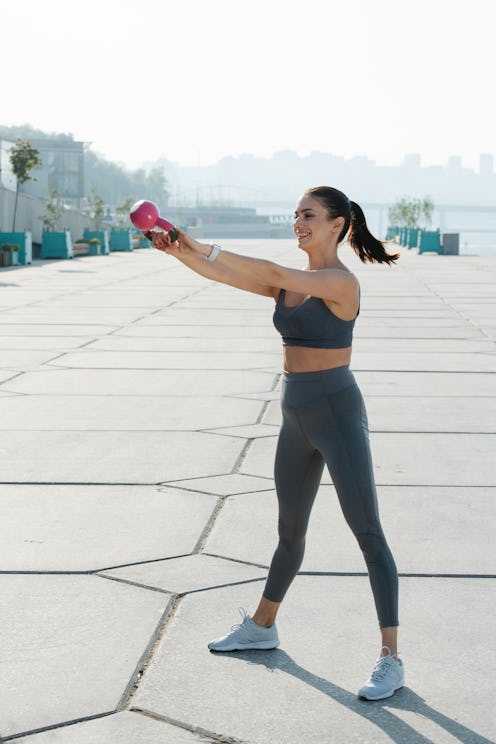Fitness
10 Muscles You Work During A Kettlebell Swing
The lowdown on the compound exercise.

Shutterstock
A kettlebell swing is a cardio and hip hinge exercise where you squat, grab a kettlebell, and then snap your hips forward to bring the weight to chest height, says trainer Conrad Sanchez. The compound move does a lot at once. Here are all the muscles worked in a kettlebell swing.
warodom changyencham/Moment/Getty Images
Glutes
The glutes are the star of the show during kettlebell swings. They engage during the squat portion and as you push your hips forward to drive the kettlebell up, Sanchez says. Add an extra glute squeeze at the top of the motion to really feel the burn.
Shutterstock
Hamstrings
The hamstring muscles down the backs of your legs also get a good workout during the exercise. That’s because they work synergistically with the glutes to drive the kettlebell up, Sanchez tells Bustle. You’ll feel them engage as you thrust your hips forward.
Shutterstock
Calves
Next up are the calves. These lower leg muscles keep your ankles stabilized as you swing and squat, Sanchez says. Because the kettlebell swing is supposed to be a quick, explosive exercise, you need all the stability you can get.
Shutterstock
Quads
The quad muscles on the fronts of your legs are the ones that extend or straighten your knees, says trainer TJ Mentus, so you know they get a lot of action as you repeatedly squat and stand to swing the kettlebell forward.
FatCamera/E+/Getty Images
Transverse Abdominus
Your abs get worked, too. “This is the deep core muscle that helps stabilize the midsection and draws the abs towards the spine,” Mentus says. He notes it’s important to keep these muscles engaged during a kettlebell swing to help protect your spine.
Shutterstock
Core
In fact, the entire core lights up during swings, says trainer Natalie Taylor. Moving a heavy weight up and down engages the erector spinae in your back, as well as your obliques, abs, and rectus abdominis muscles, she says. They all work together to create stability.
Shutterstock
Forearms
Swings also work your grip as you hang onto the kettlebell, especially if you use a heavy one. This means your hands get a workout as well as your forearms, which play a role in gripping, Mentus says. It’s one of the many functional benefits of kettlebell swings.
Shutterstock
Traps
The trapezius, aka the big muscle in your back, gets a workout as the kettlebell raises up to shoulder height, Mentus says, and also as it helps decelerate the kettlebell once it swings back between your legs.
Shutterstock
Rhomboids
If you’ve ever wondered how to work your rhomboids — aka the muscles in your upper back — kettlebell swings are where it’s at. According to Taylor, the rhomboids engage to keep your scapula and shoulders stable. Remember, KB swings are all about control.